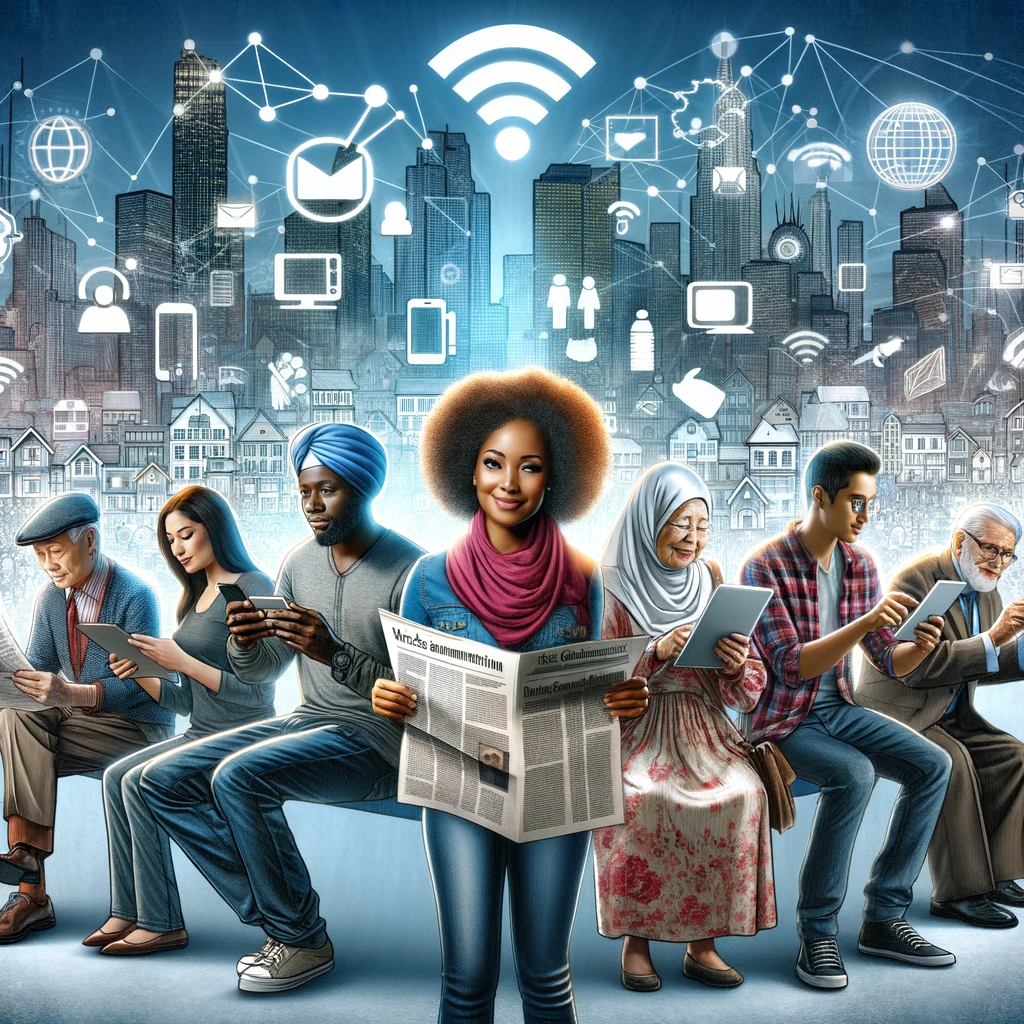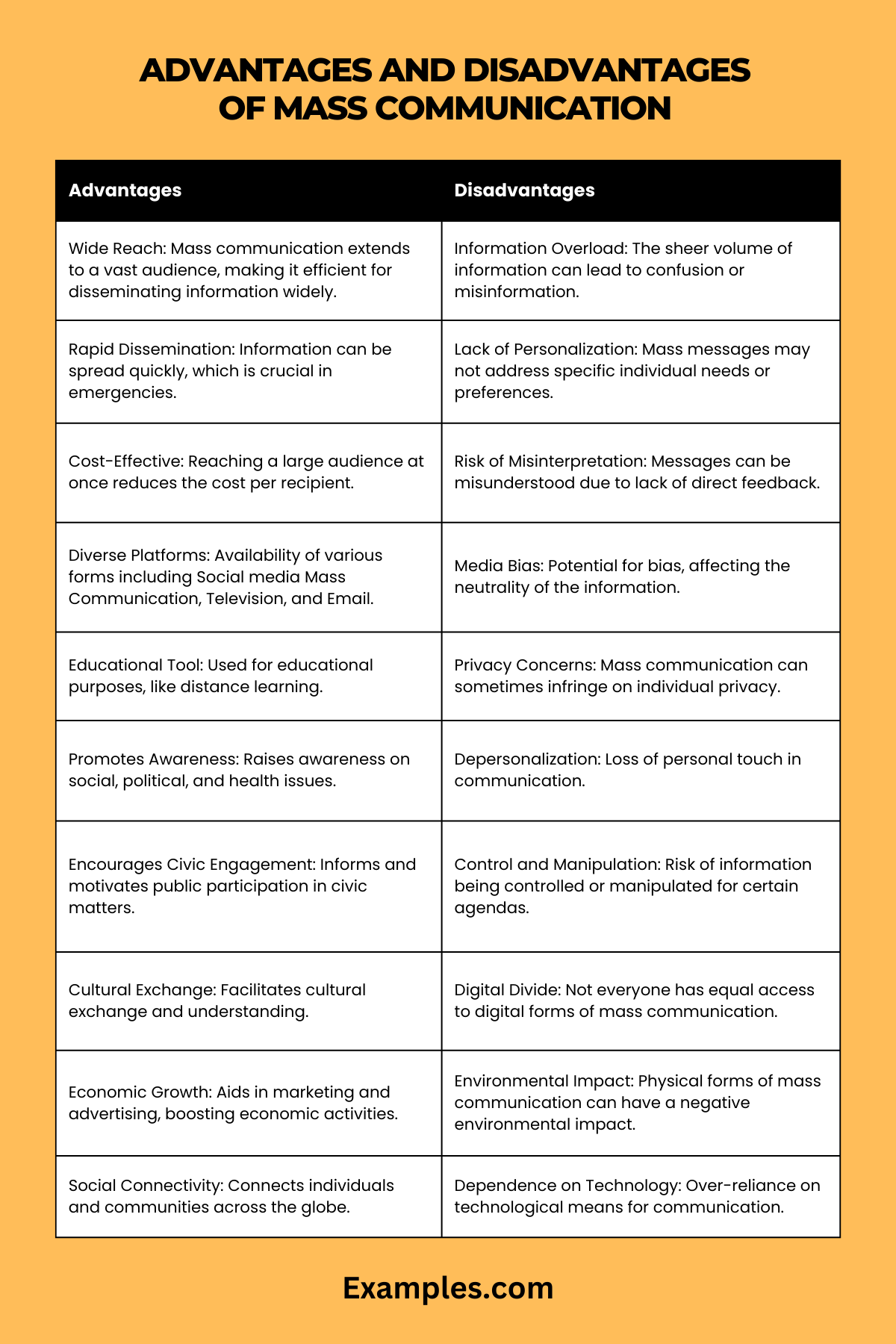Uses & Benefits of Mass Communication – Examples, Benefits, Tips
Discover the vast landscape of Mass Communication with our comprehensive guide, brimming with insightful Mass Communication Examples. Unveil how this powerful tool shapes public opinion, influences societal trends, and opens myriad career paths. From broadcasting to digital media, delve into practical uses, benefits, and real-world applications that highlight the pivotal role of mass communication in today’s interconnected world. Perfect for students, professionals, and anyone eager to understand the mechanics behind the media messages we consume daily.
50 Uses & Benefits of Mass Communication
Dive into the expansive universe of Mass Communication, a field that not only informs but transforms societies. In this guide, we explore 50 unique uses and benefits, each demonstrating how mass communication bridges gaps, shapes perceptions, and drives change. From traditional media to digital platforms, these examples offer a glimpse into the pivotal role of mass communication in our daily lives and its profound impact on global discourse.
- Broadcasting Breaking News: Essential in rapidly informing the public about urgent and developing stories. Television and radio are pivotal for immediate dissemination, complemented by online updates for depth and ongoing coverage.
- Public Health Campaigns: Key in spreading critical health-related information, like vaccination schedules or pandemic updates. Social media platforms and online forums can significantly extend the reach and engagement with diverse audiences.
- Political Campaigns and Election Coverage: Politicians and parties use mass media to communicate their platforms and policies. A strategic mix of television debates, social media campaigns, and public relations events are employed for maximum impact.
- Corporate Branding and Advertising: Businesses utilize mass communication for building and maintaining brand identity. This involves a coordinated approach across social media, television, print, and online advertising to create a unified brand image.
- Educational Broadcasting and E-Learning: Television and radio programs dedicated to educational content make learning accessible. Online platforms and social media are increasingly used for e-learning initiatives, reaching a broader audience.
- Crisis Communication and Management: Vital in managing public relations and information dissemination during emergencies. Clear, consistent messaging across various media channels, including online platforms, is crucial for effective crisis management.
- Social Awareness Campaigns: Raising awareness on critical social issues like human rights, equality, and justice. Campaigns leverage the power of social media, blogs, and video content for wider reach and deeper impact.
- Cultural Promotion and Preservation: Mass communication helps in highlighting and preserving cultural heritage, arts, and traditions through documentaries, feature articles, and online exhibitions, engaging audiences globally.
- Environmental Advocacy and Awareness: Utilized for spreading awareness and mobilizing action on environmental issues and sustainability. Digital platforms, visual content, and interactive media play a significant role in engaging and educating audiences.
- Sports Broadcasting and Reporting: Comprehensive coverage of sports events, including live broadcasting, expert commentary, and post-game analysis. The blend of live streaming, social media updates, and interactive online platforms offers a complete sports experience.
- Celebrity and Entertainment News: Providing updates and insights into the world of entertainment. Entertainment portals and social media are used to share news, interviews, and exclusive content.
- Public Service Announcements (PSAs): Addressing public welfare issues like road safety or voting rights. Radio, TV, and online videos are key channels for these impactful messages.
- Market Research and Consumer Feedback: Using mass surveys and online polls to gather consumer opinions. Social media and email campaigns are effective tools for this purpose.
- Emergency Alerts and Safety Instructions: Broadcasting urgent alerts and safety information during natural disasters or emergencies. Mobile alerts, radio, and TV broadcasts are crucial for widespread and immediate dissemination.
- Global News Coverage: Providing a window to worldwide events and international affairs. News websites, television, and print media offer diverse perspectives on global issues.
- Fashion and Lifestyle Content: Showcasing trends, styles, and lifestyle tips. Fashion blogs, magazines, and social media influencers use mass communication to influence and inform audiences.
- Human Interest Stories and Documentaries: Sharing compelling stories that evoke empathy and understanding. Documentaries on TV and online platforms bring global issues to a personal level.
- Technology and Innovation Updates: Disseminating the latest tech news and advancements. Tech blogs, podcasts, and online forums are popular channels for tech enthusiasts.
- Educational Outreach and Scholarly Communication: Universities and institutions sharing knowledge and research findings. Online lectures, webinars, and academic publications reach a wide audience.
- Advocacy for Human Rights and Social Justice: Amplifying voices and issues related to human rights. Use of online campaigns, video content, and social media movements to drive awareness and change.
- Investigative Journalism and Exposés: Uncovering and reporting on corruption, injustice, and other societal issues. Investigative reports are often published in newspapers, magazines, and online platforms.
- Religious and Spiritual Broadcasting: Sharing religious teachings and spiritual content. Television and radio programs, along with online podcasts and webcasts, cater to diverse religious audiences.
- Business and Financial News: Delivering updates on the economy, stock market, and business trends. Business news channels, websites, and print media are primary sources for financial information.
- Travel and Tourism Promotion: Showcasing destinations and travel experiences. Travel blogs, social media, and online videos inspire and inform travelers.
- Cultural and Art Festivals Coverage: Broadcasting events, festivals, and art shows. Media coverage of these events includes live streams, feature articles, and social media posts.
- Science Communication and Popularization: Making science accessible and understandable to the public. Science magazines, documentaries, and online platforms engage audiences with scientific discoveries and discussions.
- Online Tutorials and How-To Guides: Offering practical advice and instructions on various topics. YouTube channels and blogs are popular for DIY, cooking, technology, and more.
- Government Communication and Public Policy: Disseminating information about government policies and initiatives. Press releases, official websites, and social media are used for official communications.
- Community News and Local Events: Keeping communities informed about local news and events. Local newspapers and community radio stations play a vital role in this.
- Product Launches and Promotions: Introducing new products and services to the market. A mix of advertising on TV, social media, and influencer partnerships are used for promotion.
- Health and Wellness Information: Sharing tips and information on health and wellness. Health blogs, podcasts, and wellness programs on TV and online are key sources.
- Youth Engagement and Education: Engaging the younger generation through relevant content. Youth-oriented websites, social media platforms, and educational programs cater to their interests and concerns.
- Legal and Regulatory Updates: Informing the public about legal changes and regulations. Legal blogs, news websites, and newsletters are important for disseminating this information.
- Real Estate and Housing Market Trends: Covering the latest in real estate and housing. Dedicated real estate websites, TV shows, and magazines offer insights and advice.
- Art and Design Showcases: Highlighting the work of artists and designers. Online galleries, art blogs, and social media platforms are used to showcase creative work.
- Non-Profit and NGO Communication: Non-profits using mass communication to promote causes and raise awareness. Fundraising campaigns, awareness videos, and social media play a key role.
- Historical Documentaries and Features: Educating the public about historical events and figures. Historical documentaries on TV and online platforms bring history to life.
- Music Releases and Artist Promotion: Music industry using mass media to release and promote music. Music videos, streaming services, and social media are key for artist promotion.
- Automotive News and Reviews: Delivering the latest in automotive developments and reviews. Automotive blogs, magazines, and TV shows cater to car enthusiasts.
- Career Advice and Job Market Trends: Offering insights and advice on career development. Career websites, online forums, and specialized publications provide valuable information.
- Consumer Rights and Advocacy: Informing consumers about their rights and advocacy. Consumer protection websites and TV programs are important resources.
- Food and Culinary Trends: Sharing the latest in food trends and culinary arts. Food blogs, cooking shows, and social media are popular for food enthusiasts.
- Mental Health Awareness and Support: Spreading awareness and support for mental health issues. Online platforms, podcasts, and special TV programs address mental health topics.
- Sustainable Living and Eco-Friendly Practices: Promoting sustainable living and eco-friendly practices. Blogs, documentaries, and social media campaigns focus on environmental sustainability.
- Parenting Tips and Family Lifestyle: Offering advice and tips for parenting and family life. Family-oriented blogs, magazines, and TV shows provide valuable content.
- Fashion Shows and Designer Profiles: Covering fashion shows and profiling designers. Fashion channels, magazines, and online platforms showcase the latest in fashion.
- Book Releases and Author Interviews: Promoting new book releases and author interviews. Literary blogs, podcasts, and book review shows are key platforms.
- Gadget and Tech Product Reviews: Providing reviews and insights on the latest gadgets and tech products. Tech blogs, YouTube channels, and specialized magazines offer detailed reviews.
- Cinema and Movie Reviews: Offering reviews and insights into the latest movies and cinema trends. Movie review sites, blogs, and TV programs keep audiences informed.
- Virtual Events and Webinars: Facilitating virtual events and webinars for various purposes. Online platforms and social media are used for hosting and promoting these events.
Uses of Mass Communication in Your Company
Mass communication in a company setting streamlines information dissemination, enhances brand visibility, and fosters a unified corporate culture. It’s a pivotal tool in broadcasting key messages, managing public relations, and engaging both internal and external stakeholders. Effective use of mass communication can significantly impact a company’s reach and reputation.

- Company-wide Newsletters: Distribute a monthly newsletter to keep employees informed about company updates, achievements, and upcoming events. This fosters a sense of community and keeps everyone aligned with the company’s goals.
- Social Media Campaigns: Launch social media campaigns to promote new products or services. This taps into a vast audience and can significantly boost brand recognition and customer engagement.
- Internal Communication Platforms: Utilize platforms like Slack or Microsoft Teams for quick, effective internal communication. This ensures that information flows seamlessly across different departments.
- Press Releases: Issue press releases for major company announcements. This communicates important changes or achievements to the broader public and media outlets.
- Webinars and Online Conferences: Host webinars to discuss industry trends or introduce new company initiatives. This positions the company as a thought leader in its field.
- Corporate Blogs: Publish regular blog posts on the company website to discuss industry insights or company news, enhancing SEO and establishing authority in the sector.
- Email Marketing: Send targeted email campaigns to clients and prospects to promote services or products, keeping the company at the forefront of customers’ minds.
- Employee Training Videos: Create training videos for new hires or for rolling out new processes, ensuring consistent knowledge dissemination.
- Customer Feedback Surveys: Conduct surveys via email or social media to gather customer feedback, demonstrating the company’s commitment to customer satisfaction and continuous improvement.
- Town Hall Meetings: Host virtual town hall meetings to discuss company-wide issues or celebrate successes, fostering a transparent and inclusive company culture.
Benefits of Mass Communication to Society
Mass Communication plays a pivotal role in modern society, influencing social norms, shaping public opinion, and fostering community engagement. Its widespread reach allows for rapid dissemination of information, helping societies to respond swiftly to various situations. It connects people across diverse geographical and cultural backgrounds, promoting understanding and collaboration. The integration of Mass Communication in Real Life and Social media Mass Communication has revolutionized how societies interact, learn, and evolve.

Examples and Communication Strategies:
- Public Health Campaigns: Mass communication enables swift dissemination of vital health information, such as vaccination drives, contributing to community health and safety.
- Disaster Management Alerts: Utilizing Broadcasting Mass Communication for emergency broadcasts ensures rapid, widespread notification during crises.
- Environmental Awareness Programs: Mass communication plays a key role in educating society about environmental issues and sustainability practices.
- Democratic Participation: Encouraging civic engagement and informing citizens about electoral processes through various Forms of Mass Communication.
- Social Movements: Amplifying voices of social movements, enabling societal change and justice through platforms like Social media Mass Communication.
- Cultural Exchange Programs: Showcasing diverse cultures and promoting mutual respect and understanding through Television Mass Communication.
- Educational Broadcasts: Enhancing access to education through Email Mass Communication and online platforms, reaching a broader audience.
- Public Service Announcements: Addressing societal issues like drug abuse prevention through impactful Mass Communication Messages.
- Economic Updates: Keeping the society informed about economic conditions and market trends through Journalism Mass Communication.
- Community Building Initiatives: Strengthening community bonds and encouraging social participation via Mass Personal Communication methods.
Advantages and Disadvantages of Mass Communication

What are the Benefits of Studying Mass Communication?
Studying Mass Communication offers a multitude of benefits, shaping individuals into well-informed, versatile, and impactful members of society. This field, especially with its Mass Communication Examples in Journalism, provides a comprehensive understanding of how media and communication shape public opinion, culture, and societal norms.
- Diverse Career Opportunities: Graduates in mass communication have a range of career paths, including Mass Communication Jobs/Careers in journalism, public relations, advertising, broadcasting, and digital media.
- Skill Development: This field enhances critical thinking, effective writing, and public speaking skills. It also fosters the ability to analyze and interpret complex information, a vital skill in today’s information-rich world.
- Global Perspective: Students gain insights into global media systems, understanding different cultures and viewpoints, essential in a globally connected world.
- Technological Proficiency: The curriculum typically includes learning about the latest media technologies, essential for careers in Digital Age Mass Communication.
- Networking Opportunities: The study involves interacting with professionals, offering valuable networking opportunities that can lead to internships and job placements.
- Creative Expression: Mass communication allows for creative expression, whether it’s through writing, producing videos, or developing compelling advertising campaigns.
- Social Impact: It empowers students to create content that can influence society positively, addressing critical issues and advocating for change.
- Understanding Media Influence: Understanding the Models of Mass Communication and their effects on society prepares students to critically analyze media messages.
- Adaptability: The dynamic nature of the field makes students adaptable and capable of thriving in various environments – a key trait in today’s fast-paced world.
- Communication Mastery: Mastery in various forms of communication, including visual, written, and oral, prepares students for effective and persuasive communication in any context.
Why is Mass Communication so Important?
Mass Communication holds paramount importance in today’s interconnected world. It goes beyond mere dissemination of information; it shapes perceptions, influences decisions, and connects the global community.
- Widespread Information Dissemination: Mass communication enables the rapid spread of information to a broad audience, making it indispensable in emergencies and for public awareness.
- Influences Public Opinion: It plays a crucial role in shaping public opinion, as seen in various Mass Communication Examples in Journalism, where reporting can sway public views on critical issues.
- Cultural Exchange: Through Television Mass Communication and other media, it facilitates cultural exchange, promoting diversity and understanding among different communities.
- Social Change: Media can drive social change, highlighting societal issues and mobilizing public opinion and action.
- Economic Impact: In advertising and marketing, mass communication drives consumer behavior, significantly impacting the economy.
- Political Arena: It is crucial in politics, where campaign strategies, debates, and political news shape electoral outcomes.
- Education and Awareness: Mass communication is key in educating the public on various issues, from health campaigns to environmental awareness.
- Connectivity: In an era of globalization, it connects people across the globe, creating a sense of global community.
- Entertainment: It serves as a source of entertainment, providing relaxation and leisure to a wide audience.
- Accountability and Transparency: Media acts as a watchdog, ensuring transparency and accountability in public and private sectors.
Tips for Mass Communication
In the realm of Mass Communication, effectiveness and reach are key. Whether it’s through Journalism Mass Communication, Broadcasting, or Social Media, the way messages are conveyed can significantly impact their reception and influence. Here are some essential tips to optimize your mass communication efforts:
- Know Your Audience: Understanding the demographics, interests, and needs of your audience is crucial. Tailor your message to resonate with them.
- Clear and Concise Messaging: In a world bombarded with information, clarity and brevity are vital. Ensure your message is straightforward and easy to comprehend.
- Utilize Multiple Platforms: Leverage various forms of Mass Communication, like Social media Mass Communication, Email Mass Communication, and Television, to maximize reach.
- Engage with Your Audience: Interaction fosters a connection. Encourage feedback and participation to create a two-way communication stream.
- Consistency is Key: Maintain a consistent tone and style across all platforms. This helps in building a recognizable brand voice.
- Storytelling: People connect with stories. Use narrative techniques to make your message more engaging and memorable.
- Visual Appeal: Incorporate visuals like images, infographics, and videos. Visuals are processed faster by the brain and can enhance the impact of your message.
- Stay Updated with Trends: In a rapidly evolving digital landscape, staying abreast of the latest trends in Mass Communication is essential.
- Ethical Communication: Always adhere to ethical standards. Honesty and integrity in messaging build trust with your audience.
- Evaluate and Adapt: Regularly assess the effectiveness of your communication strategies and be willing to adapt as needed.
In conclusion, mass communication is fundamental in shaping a well-informed, connected, and progressive society. Its role in journalism, specifically, highlights its power in influencing public discourse and societal norms.



